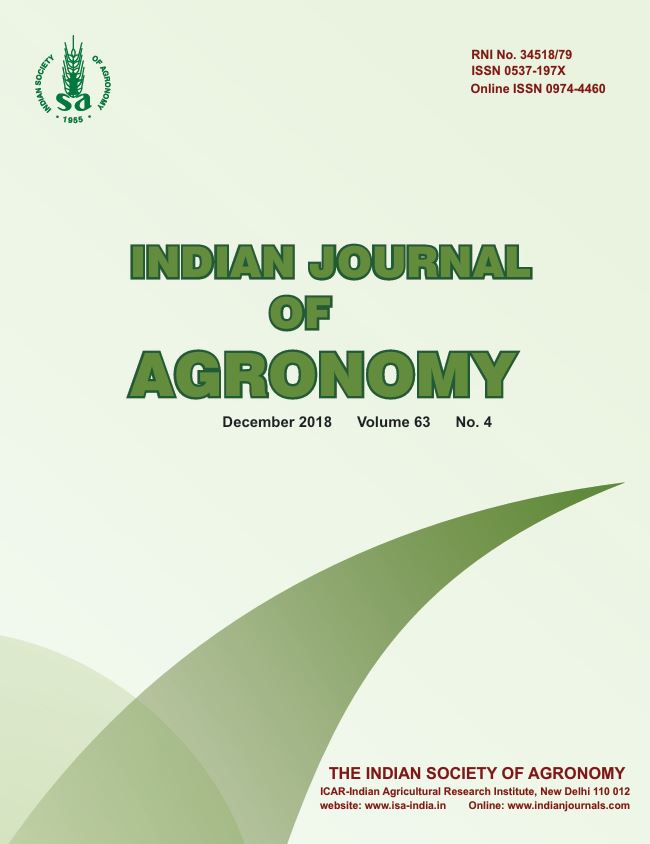Brown manuring in maize (Zea mays): Effects on weed interference and crop productivity
DOI:
https://doi.org/10.59797/ija.v63i4.5695Keywords:
Crotalaria juncea, Grain yield, Sesbania bispinosa, Weed interferenceAbstract
A field experiment was undertaken during rainy (kharif) season 2017 at ICAR-Indian Agricultural Research Institute, New Delhi to study the effects of brown manuring on weeds and maize (Zea mays L.) productivity. Season-long weed infestation (~unweeded control) resulted in the highest reduction (~41%) in grain yield of maize. Among the brown manuring (BM) treatments, growing of 1:1 mixture of Sesbania bispinosa (12.5 kg seed/ha) + Crotalaria juncea L. (12.5 kg seed/ha) supplemented with 2,4-D 0.5 kg/ha applied at 35 DAS, resulted in the highest reduction in weed density (~93%) and dry matter (~94.4%). This BM, in these regards, was comparable with the atrazine + hand weeding (HW) at 35 days after sowing (DAS) and weed-free control treatments. All BM treatments suppressed noxious weed Cyperus rotundus, which was poorly or not controlled by the recommended tank-mixture of atrazine and pendimethalin. Weed-free control resulted in the highest values of maize plant dry-matter (~210.6 g/plant), cob weight (~155.9 g/cob), and grain yield (~6.0 t/ha). The atrazine + HW, Sesbania + Crotalaria (12.5 + 12.5 kg/ha) mixture applied with 2,4-D 0.5 kg/ha at 25 DAS, Sesbania 25 kg/ha with 2,4-D 0.5 kg/ha at 25 DAS, and pendimethalin 0.75 kg/ha + atrazine 0.75 kg/ha treatments were comparable with weed-free control on maize grain yield.
References
Chalka, M.K. and Nepalia, V. 2005. Production potential and economics of maize (Zea mays) intercropped with legumes as influenced by weed control. Indian Journal of Agronomy 50(2): 119–122.
Das, T.K. 1999. Is transformation of weed data always necessary? Annals of Agricultural Research 20: 335–341.
Das, T.K. 2008. Weed Science: Basics and Applications. Jain Brothers Publishers, New Delhi, India, 901p.
Das, T.K. and Yaduraju, N.T. 2012. The effects of combining modified sowing methods with herbicide mixtures on weed interference in wheat crops. International Journal of Pest Management 58(4): 310–319.
Das, T.K., Sakhuja, P.K. and Zelleke, H. 2010. Herbicide efficacy and non-target toxicity in highland rainfed maize of Eastern Ethiopia. International Journal of Pest Management 56(4): 315–325.
Dass, S., Jat, M.L., Singh, K.P. and Rai, H.K. 2008. Agro-economic analysis of maize-based cropping system in India. Indian Journal of Fertilisers 4: 49–62.
Humphreys, E., Kukal, S.S., Christen, E.W., Hira, G.S., Singh, B., Yadav, S. and Sharma, R.K. 2010. Halting the groundwater decline in North-West India – which technologies will be winners? Advances in Agronomy 109: 155–217.
Kaur, R., Raj, R., Das, T.K., Shekhawat, K., Singh, R. and Choudhary, A.K. 2015. Weed management in pigeonpea-based cropping systems. Indian Journal of Weed Science 47(3): 267–276.
Ladha, J.K., Kumar, V., Alam, M.M, Sharma, S., Gathala, M.K., Chandna, P., Saharawat, Y.S. and Balasubramanian, V. 2009. Integrating crop and resource management technologies for enhanced productivity, profitability and sustainability of the rice–wheat system in South Asia. (In) Integrated Crop and Resource Management in the Rice–Wheat System of South Asia. Ladha J.K. et al. (Eds.). pp. 69–108. IRRI, Los Banos, Philippines.
Oyeogbe, A.I., Das, T.K., Bhatia, A. and Singh, S.B. 2017. Adaptive nitrogen and integrated weed management in conservation agriculture: impacts on agronomic productivity, greenhouse gas emissions and herbicide residues. Environmental Monitoring and Assessment 189(4): 198.
Pandey, I.B., Bharati, V., and Mishra, S.S. 2003. Effect of maize (Zea mays)-based intercropping systems on maize yield and associated weeds under rainfed condition. Indian Journal of Agronomy 48(1): 30–33.
Susha, V.S., Das, T.K., Nath, C.P., Pandey, R., Paul, S. and Ghosh, S. 2018. Impacts of tillage and herbicide mixture on weed interference, agronomic productivity and profitability of a maize–wheat system in the north-western Indo-Gangetic Plains. Field Crops Research 219: 180–191.
Tanwar, S.P.S., Singh, A.K. and Joshi, N. 2010. Changing environment and sustained crop production: A challenge for agronomy. Journal of Arid Legumes 7(2): 91–100.
USDA, 2017. URL: http://www.indexmundi.com/agriculture/?commodity=corn and graph=yield. Accessed 8 May 2017.






